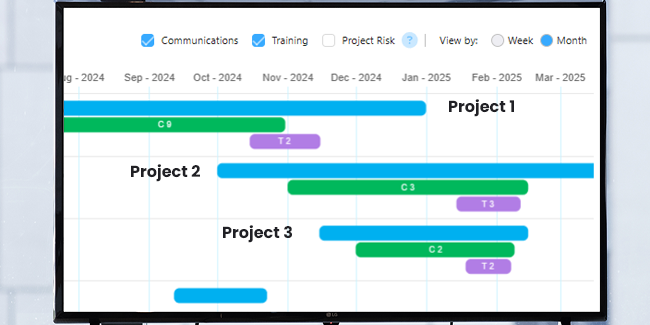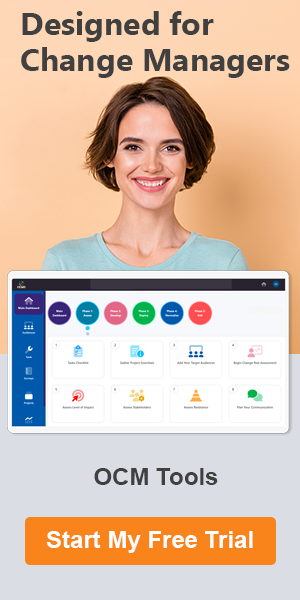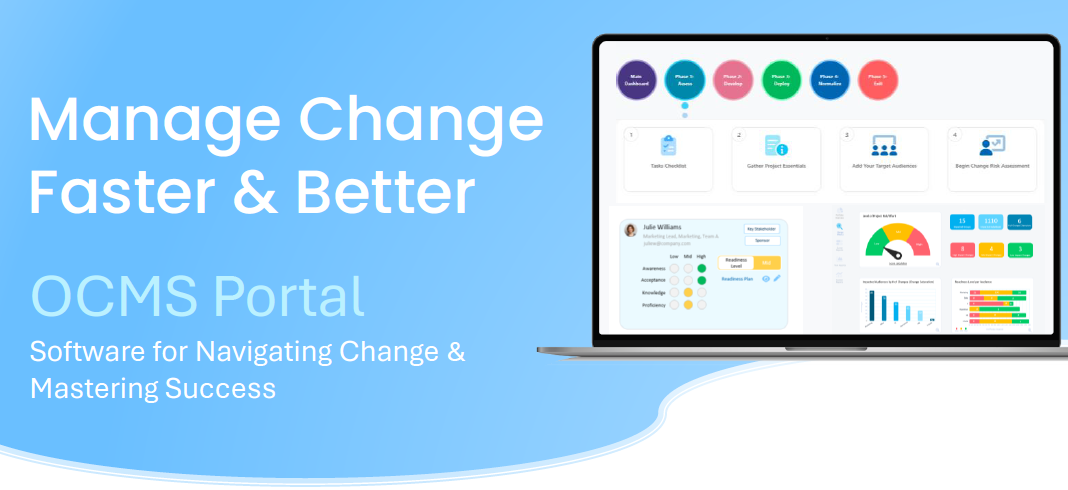AI and Change Management: A Blueprint for Successful Organizational Transformations
The rapid advancement of artificial intelligence (AI) is reshaping industries and workplaces worldwide. As businesses race to leverage AI’s potential, change management strategy for digital transformation has become an indispensable component of successful AI changes.
The rise of AI adoption in the enterprise is transforming not only how businesses operate but also how employees perform their roles. Artificial intelligence adoption initiatives are increasingly integrated into daily workflows, enhancing processes but also creating anxiety about job security and workload management.

For change management practitioners, the task is to guide organizations through these disruptive transitions by developing an effective change management strategy for digital transformation. This guide will help you understand the essentials of AI adoption and how to craft a comprehensive change management plan tailored specifically to this type of enterprise digital transformation.
Story Highlights
|
The Big Push for Artificial Intelligence Adoption
AI is no longer a futuristic concept. Organizations are investing in AI technologies to drive innovation, enhance productivity, and maintain competitiveness. From automating repetitive tasks to deriving insights from big data, AI is reshaping entire industries. The potential benefits are immense: faster processes, smarter decision-making, and enhanced customer experiences.
But alongside the excitement comes an inevitable disruption to the workforce. Employees find themselves working alongside AI tools, facing new processes, and in some cases, experiencing anxiety about job security. This is why a change management digital strategy is crucial during enterprise digital transformation and AI adoption. Successful transitions depend on addressing the human factors of AI changes, ensuring that employees are not only trained but also supported in adapting to AI-driven workflows.
Key Stats on Enterprise AI Adoption:
- A recent survey by PwC found that 86% of executives say AI is becoming a “mainstream technology” in their companies.
- AI projects in areas like customer service, marketing, and operations are now being rolled out at an unprecedented rate, with estimates suggesting adopting AI could boost business productivity by up to 40%.
Clearly, organizations are eager to harness the power of artificial intelligence skills. But to ensure a smooth transition, a solid digital transformation and change management strategy is required.
Understanding AI-Induced Changes
The adoption of AI often leads to significant organizational changes, impacting roles, responsibilities, and work processes. The importance of change management in digital transformation is apparent when you look at how AI impacts people’s roles and processes.
Some common AI changes include:
- Job Role Evolution: Repetitive tasks like data entry, scheduling, and basic customer interactions are increasingly handled by AI. As AI automates certain tasks, employees may need to acquire new artificial intelligence skills or adapt to different roles.
- Process Reengineering: AI can streamline workflows, leading to changes in how tasks are performed, and decisions are made.
- Data-Driven Decision Making: AI-powered analytics can provide valuable insights, transforming how organizations make strategic choices.
- Cultural Shifts: Embracing artificial intelligence adoption may require a shift in organizational culture, fostering a mindset of innovation and adaptability.
Please let us know if you have any questions or feedback related to AI and change management, artificial intelligence skills training, or enterprise AI adoption.
Creating a Change Management AI Plan for Technology Adoption
To successfully implement AI changes within an organization, a structured and strategic adoption and change management plan is necessary. AI adoption and IT transformation management is not just about installing new technology; it’s about reshaping the way employees work, interact, and contribute to the company’s success.
Here’s how to create an effective change management technology adoption plan for AI:
1. Define the Scope of AI Adoption
The first step is to identify how and where AI changes will be implemented within the organization. This involves working with stakeholders to clarify the following:
- Which tasks or processes will be automated?
- How will AI tools be integrated into existing systems?
- Which departments or teams will be affected?
Business impact analysis examples can help map out the effects of enterprise AI adoption on different areas of the business, guiding decision-making on where to start your AI in change management plan and how to scale the technology.
2. Define Goals and Objectives
Clearly articulate the desired outcomes of AI adoption, such as increased efficiency, improved customer satisfaction, or enhanced decision-making. This step will help when you begin creating your change management in digital transformation communication plans because you’ll be able to give the “WIIFM” (what’s in it for me) to the impacted audiences.
3. Conduct a Change Impact Assessment
Once the scope is defined, it’s crucial to assess the impact of AI on the workforce. Conduct a detailed change impact analysis to identify:
- Which roles will be most affected by AI?
- What changes in job responsibilities and workflows can be expected?
- What new artificial intelligence skills will be required?
By understanding the scope of the change impact, you can better prepare your workforce and mitigate risks such as productivity dips or increased resistance. The impact assessment should outline who is impacted, how they are impacted, and the severity of the impacts. This will guide your change management and digital transformation audience engagement plan.
4. Address Resistance to the Adoption of AI
Resistance to change, especially due to concerns over job loss, is one of the most significant challenges in AI and change management. A proactive change management strategy should include tactics to address these fears and minimize pushback.
Key strategies include:
- Transparent Communication: Be clear about how adopting AI will affect roles and responsibilities. When crafting your digital transformation and change management communication plan, highlight the benefits of AI, such as reducing mundane tasks and creating opportunities for more fulfilling work.
- Training and Upskilling: Provide robust training programs to help employees adapt to AI-driven workflows. Focus on reskilling employees to take on higher-value roles that cannot be easily automated.
- Engage Leadership and Champions: Involve leaders who are enthusiastic about artificial intelligence adoption in driving positive messaging and engagement. Identify change champions within teams to advocate for the benefits of AI adoption in the enterprise.
5. Monitor and Evaluate AI Adoption and Change Management Progress
Regularly track the progress of AI adoption and assess the effectiveness of change management digital initiatives. Make adjustments as needed to ensure alignment with goals and address emerging challenges.
Do you have any experiences to share about supporting adopting AI in change management initiatives or the importance of change management in digital transformation? Please reach out and let us know!
Avoiding Change Saturation During IT Transformation Management
One of the biggest risks during a change management AI digital transformation is change saturation—where employees are overwhelmed by the volume of new tools, processes, and systems being introduced. With multiple changes happening simultaneously, such as integrating new AI tools while implementing other digital transformation initiatives, employees may feel overburdened, leading to disengagement or burnout.
To avoid change saturation during enterprise digital transformation:
- Prioritize Initiatives: Implement AI changes in phases rather than all at once. This helps prevent overwhelming employees and allows for better focus on specific tasks.
- Monitor Employee Feedback: Regularly check in with teams to gauge how they’re coping with the changes. Adjust AI in change management timelines if needed based on feedback.
- Provide Ongoing Support: Ensure there is continuous support post-launch, including technical assistance and access to resources that help employees navigate the AI adoption changes effectively.
- Use Tools that Offer Portfolio-Level Visibility: Avoiding change management and digital transformation saturation and overlap is easier if you have a change management tool that shows training and communications timelines for employees across all enterprise projects.
By managing change saturation, you can improve the success rate of your artificial intelligence adoption projects and maintain a high level of employee engagement.

OCMS Portal change management solution provides detailed portfolio level dashboard views to help organizations avoid change saturation.
Please let us know if you have any questions about digital transformation and change management, supporting AI enterprise digital transformation, or change management technology adoption.
Aligning AI Adoption with Digital Transformation Goals
AI technology is often at the forefront of an organization’s digital transformation strategy. As such, it’s essential that AI projects are aligned with the broader goals of digital transformation and change management.
Here’s how to ensure alignment:
- Align AI Initiatives with Business Objectives: AI projects should directly support your company’s larger strategic goals. Whether the goal is to improve operational efficiency, enhance customer experiences, or increase revenue, AI should serve as a tool to advance these objectives.
- Integrate AI with Existing Systems: AI tools need to complement existing technologies and processes, not replace them entirely. Ensure AI solutions integrate smoothly into current systems to avoid disrupting business continuity.
- Use Change Management Best Practices: Effective change management in digital transformation ensures that the technical aspects of the adoption of AI are matched by the human readiness to embrace the change. This involves regular communication, training, and leadership engagement to facilitate smooth transitions.
The Role of Change Management in AI Success
AI is reshaping industries at an accelerating pace, but without an effective AI adoption and change management strategy, even the most advanced AI tools can fail to deliver their full potential.
By focusing on AI and change management in digital transformation, organizations can ensure that employees are fully prepared for the shifts in workflows and responsibilities that AI adoption will bring.
Remember that the key to success lies in planning for change, managing resistance, and avoiding change saturation. With a well-executed change management strategy for digital transformation, your organization can harness the full potential of AI while keeping employees engaged, motivated, and prepared for the future.
Conclusion: Change Management Digital AI Guide
As more organizations embrace artificial intelligence adoption, the need for structured change management technology adoption strategies becomes even more critical. By understanding the impact of AI changes on employees and crafting a tailored change management plan that addresses resistance and supports continuous learning, change management practitioners can lead their organizations through successful enterprise AI adoption.
How has enterprise AI adoption changed how you approach digital adoption and change management strategies? We’d love to hear your thoughts on supporting all these AI changes.
Leading Change Management Tools to Support Your Success
Need the OCM tools to help you lead successful enterprise digital transformations? OCMS Portal was created by and for change managers. It includes all the tools you need to identify, assess, and manage digital transformation and change management.
From portfolio-level views to automated engagement plans, OCMS Portal helps you work more effectively, whether you’re supporting change management AI projects or any other type of initiative.
FAQ: AI in Change Management Planning
What are some common AI changes to consider for change management?
When planning for AI adoption and change management, some of the common changes are job role evolution, process reengineering, data-driven decision-making, and cultural shifts.
What are some questions to ask when defining the scope of the adoption of AI?
When defining the scope of a project adopting AI, some of the change management digital questions to answer are:
Which tasks or processes will be automated?
How will AI tools be integrated into existing systems?
Which departments or teams will be affected?
How do you avoid change saturation during IT transformation management?
Some ways to avoid change saturation when supporting digital transformation and change management AI projects include prioritizing initiatives, monitoring employee feedback, providing ongoing support, and using tools that offer portfolio-level visibility.
Note: Content on OCM Solution's ocmsolution.com website is protected by copyright. Should you have any questions or comments regarding this OCM Solutions page, please reach out to Ogbe Airiodion (Change Management Lead) or the OCM Solutions Team today.
External Sources: stock.adobe.com





